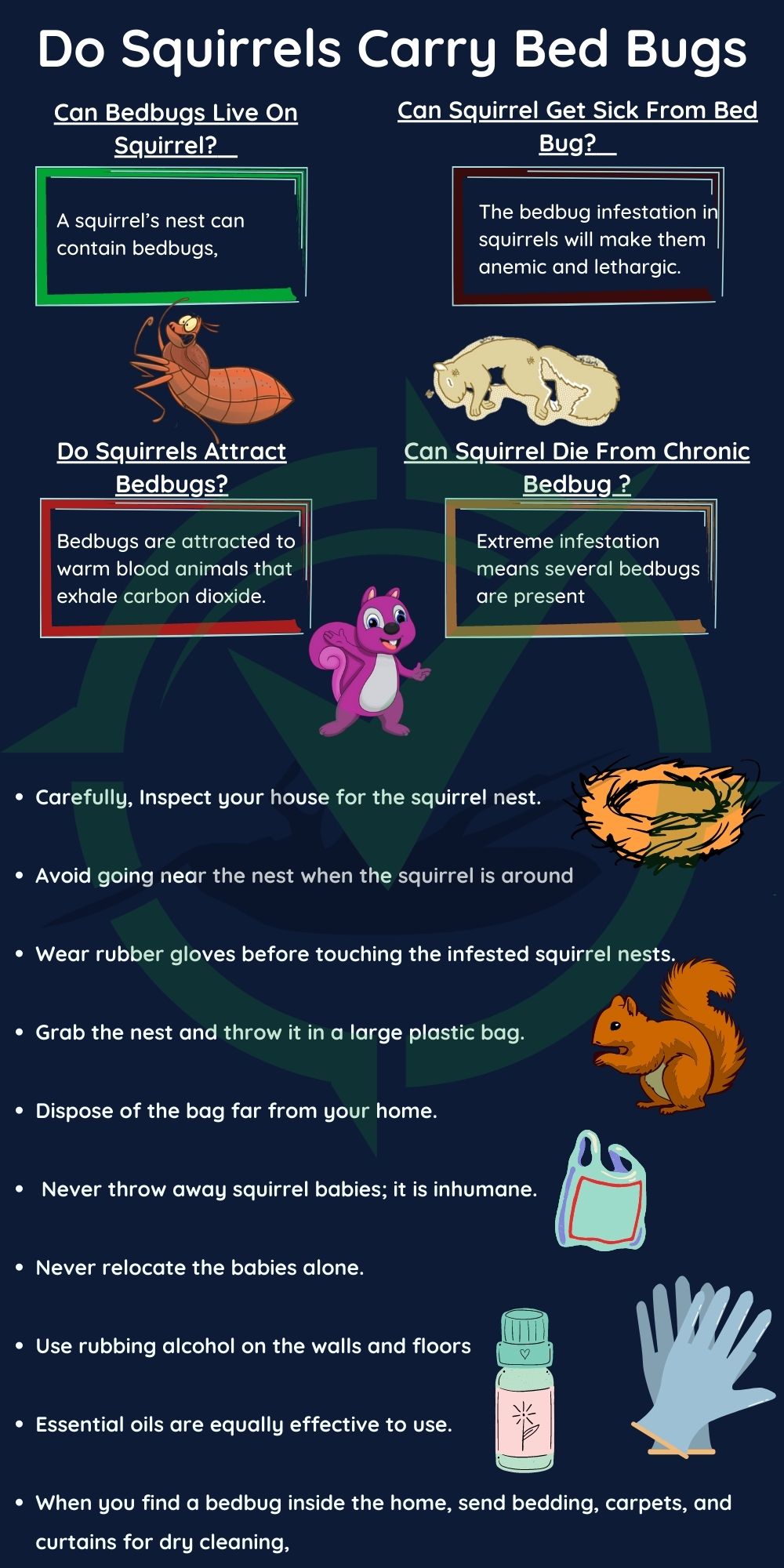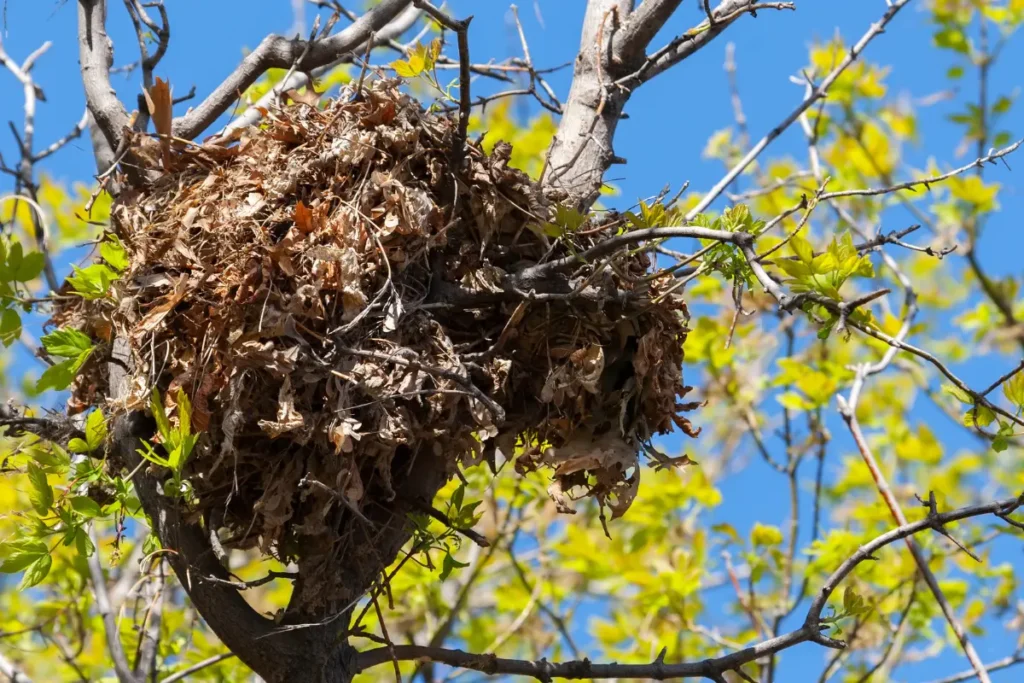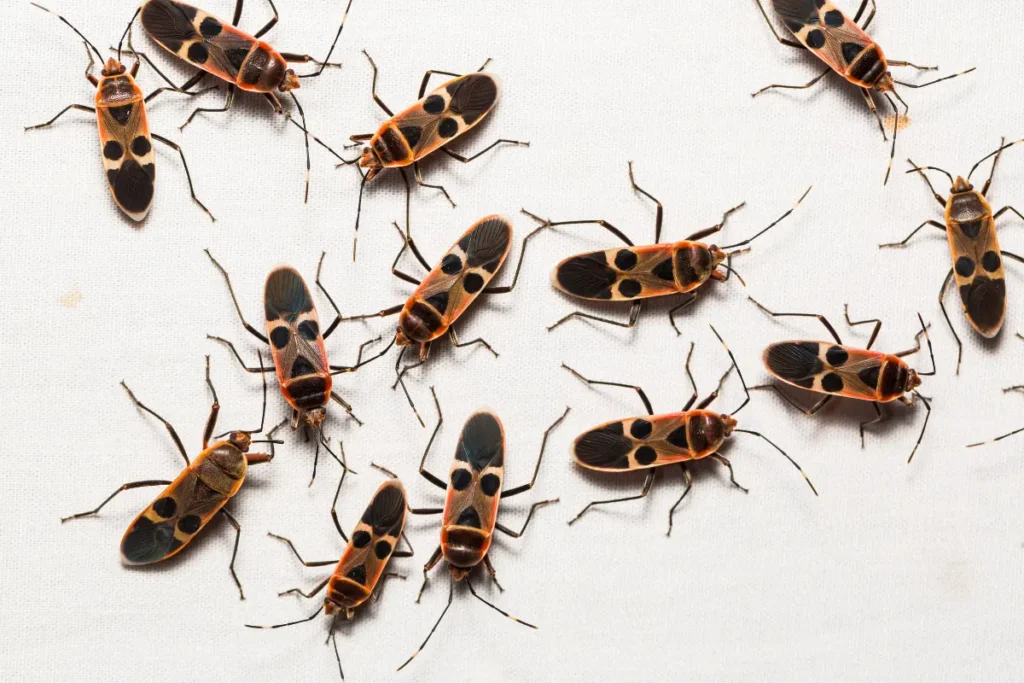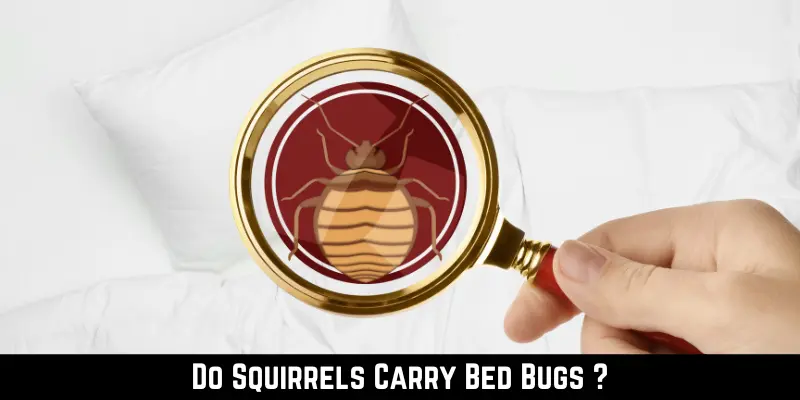Wild Squirrels in your surrounding areas are cute and playful. At the same time, they are destructive and can carry many harmful microorganisms that are dangerous to your health. You must be wondering, do squirrels carry bed bugs?
Yes. Squirrels can carry bedbugs. They are small reddish-brown insects that feed on the host blood. Bedbugs can live inside the squirrel nest. Bedbugs are more attracted to humans than animals due to carbon dioxide production.
Bedbug infestation is common. It is contagious and causes mild to severe allergic reactions in humans. Continue reading the article to find more detail on bedbugs and methods to get rid of them.

Can Bedbugs Live On Squirrel?

Bedbugs are not attached to any animal, unlike fleas. They come out at night to feed on human or animal blood and will go back to their hiding space.
A squirrel’s nest can contain bedbugs, but they do not live on the squirrel’s body. Bedbugs are excellent at hiding. They can hide inside the squirrel fur and move from one place to another. Therefore, bedbugs are also known to be excellent hitchhikers.
Typically, a squirrel nest is more problematic in bedbugs infestation. Bedbugs living in the nest will continue to move inside buildings.
A squirrel itself might transfer one or two bedbugs which are easy to handle. But when you have a squirrel nest on your property, it will be a chronic infestation.
Can Squirrel Get Sick From Bed Bug?

Bedbugs suck blood to survive. The bedbug infestation in squirrels will make them anemic and lethargic. A single bedbug can suck blood up to six times its weight within three to ten minutes. After a good blood meal, bedbug size can increase to almost seven millimeters.
The squirrel will have reddish bite marks and blisters all over the skin. The continuous biting can cause the skin to swell, and the squirrel will be too weak to move.
The appetite will increase due to the loss of blood. Chronic bedbug infestation inside the nest can kill squirrels due to a large volume of blood loss and starvation. Blood loss makes squirrels slow and dull. They will feel weak to go out in search of food.
Do Bedbugs Live In Squirrel Nests?

Bedbugs thrive in a warm and cozy environment that provides them with plenty of nutrition and hiding space. They can live in squirrel nests and thrive there. Bedbugs living inside the squirrel nest are usually the cause of the infestation in other animals and homes.
Squirrels build their nest on trees. The bedbugs from the infested squirrel nest can crawl into neighboring areas and even inside the connecting house. This tiny crawling parasite typically lives inside the squirrel fur but can live in the squirrel nest.
Without a blood meal, bedbugs can live up to three months. Therefore, when a squirrel abandons the nest or when it dies, bedbugs can live in its nest for many weeks. During this time, it moves to a different location in search of the next host or dies of malnutrition.
Do Squirrels Attract Bedbugs?

Bedbugs are attracted to warm-blooded animals that exhale carbon dioxide, and Squirrels are warm-blooded organisms that breathe in oxygen and breathe out carbon dioxide. Therefore, bedbugs are attracted to squirrels.
The presence of carbon dioxide is an indication for bedbugs that there is a good source of energy. That will provide them with sizeable nutrition to grow. When a squirrel breathes, it is an indication to bedbugs that there is a food source nearby.
As indicated by the name, warm-blooded animals generate a lot of body heat. It provides an ideal temperature for bedbugs to survive. The perfect temperature for an adult bedbug to do well in is between 21 to 32 degrees Celsius.
Subsequently, the absolute temperature of the squirrel body lies between 32 and 40 degrees Celsius, providing a favorable environment for bedbugs to thrive.
Can Squirrel Die From Chronic Bedbug Infestation?
Bedbugs suck blood from their host, causing anemia. Extreme infestation means several bedbugs are present on the squirrel fur and are taking their nutrition from the blood. Therefore, any food the squirrel is eating will not benefit it at all.
A single bedbug can suck blood up to six times its body weight. It explains that each bedbug can drink up to 0.036 milliliter of blood within ten minutes. In chronic infestation, bedbugs can suck squirrel blood in liters in a few days.
With a good nutrition supply, bedbugs can survive for ten months. A mature squirrel with chronic bed bug infestation can live for weeks to months.
However, the baby squirrel can die within a few days from bedbug infestation as they have a weak immune system and cannot bear the rapid blood loss.
How To Get Rid Of Squirrels Carrying Bedbugs From Your House?
Squirrels are one of the leading carriers of bedbugs, especially the wild squirrel that has probably nested inside your home. To get rid of bedbug infestation from the house means you will have to get rid of your cute and friendly neighbor that keeps visiting.
Getting rid of bedbug infestation without removing the squirrel is quite complicated, as the squirrel hides bedbugs inside its fur. Bedbugs are so tiny that they can crawl inside through squirrel nests into your house, and you will not even notice them until the infestation becomes chronic.
Therefore, follow the tips and tricks below and eliminate the bedbugs carrying squirrels from your home.
- Carefully, Inspect your house for the squirrel nest. Squirrels build their nest inside attics, rooftops, and outside on the tallest tree in your yard. You can also find the squirrel nest in a birdhouse.
- Avoid going near the nest when the squirrel is around because the squirrel will be alert. It will make loud noises and will make your work more difficult.
- Wear rubber gloves before touching the infested squirrel nests. Grab the nest and throw it in a large plastic bag.
- Dispose of the bag far from your home. At least forty feet away from your house.
- Throwing away the nest can be complicated when squirrel babies are inside it. Never throw away squirrel babies; it is inhumane. Call any wildlife services or try relocating the nest.
- Never relocate the babies alone. Use a live trap for the mother and babies and move them miles away from your house.
- After getting rid of squirrels, reexamine the area for the sign of bedbugs.
- Use rubbing alcohol on the walls and floors to kill bedbugs and their eggs.
- Essential oils are equally effective to use outside and inside the home to kill bedbugs and their eggs.
- When you find a bedbug inside the home, send bedding, carpets, and curtains for dry cleaning, and use insecticide and diluted bleach solution on the furniture.
What Other Parasites Do Squirrels Carry?
Squirrels can carry several parasites besides bedbugs, including ticks, fleas, and mites. They also transfer diseases caused by bacteria, viruses, and fungi. Squirrels can pass on all these parasites to humans.
The parasites living on the squirrel will eventually move inside via small cracks and spaces in the house exterior. The main entrance point of parasites is a chimney, windows, doors, attics, and holes in the roof and vents.
These parasites are hazardous for humans as they can cause allergic reactions and are difficult to deal with. They all are small crawling insects and can easily hide inside dark corners.
Plus, they thrive in warm environments inside the home, especially in the bathroom, closets, and bedding.
Conclusion
Squirrels carry many tiny parasites, including bedbugs which can hide inside the fur and move from one place to another. Bedbugs thrive in a warm, humid environment with a high concentration of carbon dioxide. Therefore, they are more attracted to warm-blooded animals.
Initially, bedbugs are translucent or white-yellowish, but after a blood meal, their size and color change drastically to reddish-brown, and they can swell up.
Bedbugs can crawl inside the home from squirrel nests through gaps and holes in walls, windows, doors, vents, chimneys, and attic. To get rid of bedbugs from your house, first, you must get rid of a squirrel and its nest.
References
Association between bed bugs and allergic reactions– Journal of Parasite immunology
Madhavi L. Kakumanu, Zachary C. DeVries, Alexis M. Barbarin, Richard G. Santangelo, Coby Schal, Bed bugs shape the indoor microbial community composition of infested homes, Science of The Total Environment, Volume 743, 2020


